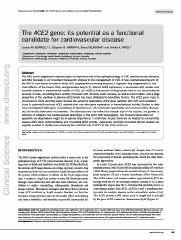Please use this identifier to cite or link to this item:
https://ahro.austin.org.au/austinjspui/handle/1/11576Full metadata record
| DC Field | Value | Language |
|---|---|---|
| dc.contributor.author | Burrell, Louise M | en |
| dc.contributor.author | Harrap, Stephen B | en |
| dc.contributor.author | Velkoska, Elena | en |
| dc.contributor.author | Patel, Sheila K | en |
| dc.date.accessioned | 2015-05-16T01:11:27Z | |
| dc.date.available | 2015-05-16T01:11:27Z | |
| dc.date.issued | 2013-01-01 | en |
| dc.identifier.citation | Clinical Science 2013; 124(2): 65-76 | en |
| dc.identifier.govdoc | 23013041 | en |
| dc.identifier.other | PUBMED | en |
| dc.identifier.uri | https://ahro.austin.org.au/austinjspui/handle/1/11576 | en |
| dc.description.abstract | The RAS (renin-angiotensin system) plays an important role in the pathophysiology of CVD (cardiovascular disease), and RAS blockade is an important therapeutic strategy in the management of CVD. A new counterbalancing arm of the RAS is now known to exist in which ACE (angiotensin-converting enzyme) 2 degrades Ang (angiotensin) II, the main effector of the classic RAS, and generates Ang-(1-7). Altered ACE2 expression is associated with cardiac and vascular disease in experimental models of CVD, and ACE2 is increased in failing human hearts and atherosclerotic vessels. In man, circulating ACE2 activity increases with coronary heart disease, as well as heart failure, and a large proportion of the variation in plasma ACE2 levels has been attributed to hereditary factors. The ACE2 gene maps to chromosome Xp22 and this paper reviews the evidence associating ACE2 gene variation with CVD and considers clues to potential functional ACE2 variants that may alter gene expression or transcriptional activity. Studies to date have investigated ACE2 gene associations in hypertension, left ventricular hypertrophy and coronary artery disease, but the results have been inconsistent. The discrepancies may reflect the sample size of the studies, the gender or ethnicity of subjects, the cardiovascular phenotype or the ACE2 SNP investigated. The frequent observation of apparent sex-dependence might be of special importance, if confirmed. As yet, there are no studies to concurrently assess ACE2 gene polymorphisms and circulating ACE2 activity. Large-scale carefully conducted clinical studies are urgently needed to clarify more precisely the potential role of ACE2 in the CVD continuum. | en |
| dc.language.iso | en | en |
| dc.subject.other | Angiotensin II.metabolism | en |
| dc.subject.other | Blood Pressure.genetics | en |
| dc.subject.other | Cardiovascular Diseases.blood.genetics.physiopathology | en |
| dc.subject.other | Genetic Variation | en |
| dc.subject.other | Haplotypes.genetics | en |
| dc.subject.other | Humans | en |
| dc.subject.other | Peptidyl-Dipeptidase A.blood.genetics | en |
| dc.subject.other | Renin-Angiotensin System.physiology | en |
| dc.subject.other | Sex Factors | en |
| dc.title | The ACE2 gene: its potential as a functional candidate for cardiovascular disease. | en |
| dc.type | Journal Article | en |
| dc.identifier.journaltitle | Clinical Science | en |
| dc.identifier.affiliation | Department of Medicine, Austin Health, The University of Melbourne, Heidelberg, Victoria, Australia | en |
| dc.identifier.doi | 10.1042/CS20120269 | en |
| dc.description.pages | 65-76 | en |
| dc.relation.url | https://pubmed.ncbi.nlm.nih.gov/23013041 | en |
| dc.type.austin | Journal Article | en |
| local.name.researcher | Burrell, Louise M | |
| item.fulltext | With Fulltext | - |
| item.languageiso639-1 | en | - |
| item.grantfulltext | open | - |
| item.openairetype | Journal Article | - |
| item.openairecristype | http://purl.org/coar/resource_type/c_18cf | - |
| item.cerifentitytype | Publications | - |
| crisitem.author.dept | Cardiology | - |
| crisitem.author.dept | General Medicine | - |
| crisitem.author.dept | Medicine (University of Melbourne) | - |
| crisitem.author.dept | Medicine (University of Melbourne) | - |
| Appears in Collections: | Journal articles | |
Files in This Item:
| File | Description | Size | Format | |
|---|---|---|---|---|
| 23013041.pdf | 447.33 kB | Adobe PDF |  View/Open |
Page view(s)
72
checked on Feb 6, 2025
Download(s)
312
checked on Feb 6, 2025
Google ScholarTM
Check
Items in AHRO are protected by copyright, with all rights reserved, unless otherwise indicated.
